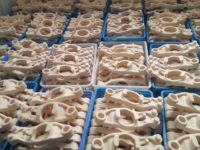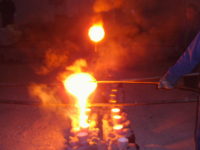Our investment precision casting in wax are divided in hard wax silica sol and lost wax water glass moulding.
Both casting processes are the same. A wax pattern of the part is made through an aluminum mould tool. The wax pattern is then dipped in a refractory slurry to create a mould around the wax. The wax is then heated and melted out of the mould pattern. After the mould has been hardened the molten metal is poured into the mould and allowed to cool.
Lost wax has a general tolerance of CT 8 – CT 9 and is very cost efficient for parts with higher demands. Examples: machine and vehicle axles and suspensions.
Hard wax is harder and packs the mould better, hence this process has a casting tolerance CT from 5 CT – 7 CT. Very efficient to reduce or save machining costs.
Advantages of wax casting:
- Greater accuracy
- Create products with precise dimensions
- Create intricate, complex parts that have thin walls
- The ability to cast ferrous and non-ferrous materials
- High-quality, smooth finishes that require minimal machining
CT 5 - CT 9
< 40 kg
Steel














